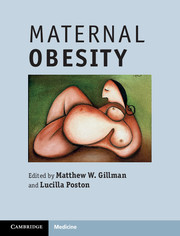Book contents
- Frontmatter
- Contents
- Contributors
- Preface
- Section 1 Trends and determinants of obesity in women of reproductive age
- Section 2 Pregnancy outcome
- Section 3 Long-term consequences
- Section 4 Interventions
- Section 5 Management and policy
- 18 Clinical management of obesity in pregnancy
- 19 Public health policies relating to obesity in childbearing women
- Index
- Plate Section
- References
18 - Clinical management of obesity in pregnancy
from Section 5 - Management and policy
Published online by Cambridge University Press: 05 August 2012
- Frontmatter
- Contents
- Contributors
- Preface
- Section 1 Trends and determinants of obesity in women of reproductive age
- Section 2 Pregnancy outcome
- Section 3 Long-term consequences
- Section 4 Interventions
- Section 5 Management and policy
- 18 Clinical management of obesity in pregnancy
- 19 Public health policies relating to obesity in childbearing women
- Index
- Plate Section
- References
Summary
Introduction
Obesity is now the commonest antenatal co-morbidity. With one in five of the antenatal population in both the US and the UK being obese, maternal obesity will inevitably be encountered by all obstetricians, from those with a special interest in high-risk obstetrics, to those covering the delivery suite out of hours. Therefore it is essential that all clinicians have the knowledge and expertise to manage obese women during pregnancy and labor.
As reviewed in Chapter 4 pregnant women who are obese are at greater risk of a wide range of pregnancy complications from pre-pregnancy, throughout the antenatal period, intrapartum, and postnatally (Table 18.1). The offspring of obese mothers are also at greater risk of perinatal morbidity and long-term health problems. There are also technical challenges such as the availability of appropriate equipment and moving and handling problems.
This chapter aims to provide a summary of the clinical management of obesity in pregnancy, based on evidence where it exists, and highlighting areas where further research is needed.
Pre-pregnancy care
Primary care services have a responsibility to ensure that all women of childbearing age are aware of the excess risks associated with obesity in pregnancy [ 1 ] . Any visit to a health care provider by a young woman who is overweight should be viewed as an opportunity to advise about the benei ts of weight loss and strategies to achieve this [ 2 ]. Overweight women planning a pregnancy should be given the opportunity and encouragement to optimize their pre-pregnancy weight. Losing 5% to 10% of their body weight prior to conception has signii cant health benei ts [3, 4] . For example, minimal weight loss in women with polycystic ovarian syndrome and anovulation can result in ovulation induction, restoration of fertility, and spontaneous conception. Rapid weight loss immediately prior to pregnancy should not be encouraged as it is associated with poorer outcomes [2].
- Type
- Chapter
- Information
- Maternal Obesity , pp. 223 - 236Publisher: Cambridge University PressPrint publication year: 2012
References
- 1
- Cited by

